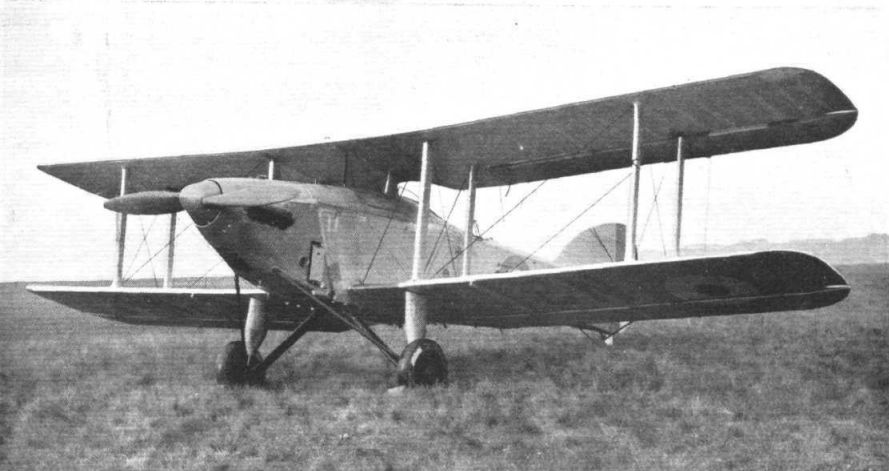
Flight, January 1928
THE HANDLEY PAGE "HARROW" MARK II
Napier "Lion" Engine
IT is now several weeks since the first public demonstration was given at Cricklewood of the new Handley Page automatic slot fitted to a Bristol Fighter. In the meantime, the automatic slots have been or are being experimentally fitted to quite a number of aeroplanes, and some interesting test results should be available before long. One of the first machines to be so fitted was the new Handley Page "Harrow" Mark II, a torpedo or bombing machine fitted with Napier "Lion" engine, with which some very excellent results are believed to have been obtained. The machine has not hitherto been available for description, but it has now become possible to refer to it in a general way.
The "Harrow II" is a tractor biplane of fairly normal type, but in which quite obviously considerable care has been taken to "clean up" the aerodynamic design by reducing projections to a minimum. The nose in particular gives evidence of this, the tapering form offering a good entry for the air and causing a minimum of interference between the propeller and the fuselage. The two cockpits also indicate care in aerodynamic design, and are as nearly "faired in" as is possible in a military machine which has to have its rear guns exposed and its gunner able to stand up and fire.
It is, however, in effect of the slots that the greatest interest of this machine lies. Full performance figures may not be given at the moment, but that the slots are effective (and, incidentally, lift slots as well as control slots are fitted) appears evident from the fact that, although weighing well over 7,000 lbs. "all-up," the "Harrow II" has a speed range of from 50 m.p.h. (80 km./h.) to 136 m.p.h. (220 km./h.) with full load, a speed range of 2-72 to 1. For the relatively heavy power loading such a range is remarkably good.
At present it is not possible to say exactly what "useful load" the machine carries, but the fact that it is designed, either as a torpedo plane or as a bomber indicates that this load is considerable.
Описание:
- Flight, January 1928
THE HANDLEY PAGE "HARROW" MARK II - Flight, July 1928
THE HANDLEY PAGE "HARROW”
Фотографии
-
Flight 1928-07 / Flight
THE HANDLEY PAGE "HARROW II": Three-quarter front view.
-
Flight 1939-06 / Flight
Регистрационный номер: N205 [4] The original Harrow was a torpedo machine, and should not be confused with the big twin-engined bomber now used by the R.A.F.
-
Flight 1928-01 / Flight
Регистрационный номер: N205 [4] THE AUTOMATIC SLOT IN ACTION: Two views of the Handley Page "Harrow II," with Napier "Lion" engine. The position of the elevator indicates that the machine is not being "hoicked" into the air.
-
Air Pictorial 1955-12 / The journal of a roving spotter
Регистрационный номер: N205 [4] HANDLEY PAGE H.P.31 HARROW. A two-seat, general purpose, shipborne torpedo aircraft, the Harrow 2 could be fitted with a 550-h.p. Napier Lion Xl , 480-h.p. Rolls Royce F.XII.A, 450-h .p. Bristol Jupiter VIII, or 450-h.p. Lorraine Dietrich engine. This machine had a 470-h.p. Lion V. Floats could be fitted as an alternative to wheeled undercarriage. Provision was made for a Vickers gun firing forward and a Lewis gun on a Scarff ring aft. Span was 44 ft., length 34 ft.; height 13 ft. 4 in.; wing area 563 sq. ft. ; top speed 115 m.p. h. at 1.000 ft. and loaded weight 7,140 lb. (These figures are supplied by the manufacturer which differ from reference books of the period.)
The photograph shows the Harrow Mk.II (N205) with the more powerful 530.h.p. Lion Mk.IXA. the re-shaped nose (plus spinner) and the cut-down rear fuselage.
The H.P.31 Harrow was designed to A.M. Spec. 21/23 as a two-seat carrier-borne torpedo bomber. A second Harrow was fitted with a twin-float undercarriage and is claimed to be the first military seaplane incorporating the then revolutionary leading-edge wing slats - the patented Lachmann-Handley Page "Slot". The Harrow was otherwise of conventional design and of all-wood construction. The two-bay wings could be folded back to a mere 18 ft. for carrier stowage. Armament consisted of a .303-in. machine gun above the engine on the starboard side of the nose, plus the single rear gun . -
Flight 1928-01 / Flight
Automatic Slots: View showing the wing tip slots on the Handley Page "Harrow II."
-
Air Pictorial 1955-12 / The journal of a roving spotter
HANDLEY PAGE H.P.31 HARROW. Data: Manufacturer: Handley Page Ltd., Cricklewood, London. N.W.2. Harrow Mk. I (landplane: first flight, 24th April 1926). Power plant: one 470-h.p. Napier Lion VA. Dimensions: span 44 ft.; length 33 ft. 9 5/8 in.; height (tail down) 13 ft . 3 in.; wing area 563 sq. ft. Weights: empty 4.403 lb.: disposable 2.737 lb. (including 1,650-lb. war load); loaded 7.140 lb. Performance: maximum speed 115 rn.p.h, at 15,000 ft.; cruising 98 m.p.h.; range 440 miles. Tank capacity: 160 Imp. gal.
- Фотографии






